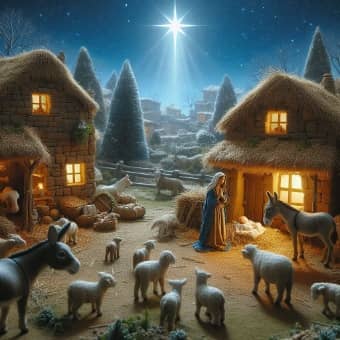Uncovering the Historical Significance of Donkeys During the Time of Jesus
The donkey, a humble yet crucial figure, carries a legacy that is often overshadowed by the pages of grand historical and religious narratives. However, during the era when Jesus was born, these sturdy beasts of burden carried out roles of immense importance.
This blog post contains affiliate links. When you click on a link on this page and make a purchase I may earn a small commission, at no additional cost to you. Thank you for your support.
Donkeys in Daily Life and Labor
Around the time of Jesus, donkeys were an integral part of daily life, particularly in the regions of the Middle East. Their robust constitution made them perfectly adapted to the arid climates and tough terrains.
Donkeys were employed for a variety of tasks ranging from agriculture to transportation. Farmers relied on donkeys to plow fields and transport produce to markets. Their endurance and ability to carry heavy loads made them more accessible to the common people than horses, which were often a mark of wealth and status.

A Symbol of Peace and Prophecy
In the religious context, donkeys hold special prominence, and their gentle nature symbolized peace. According to Biblical accounts, Jesus’s entry into Jerusalem on a donkey reflected the fulfillment of ancient prophecies. Zechariah 9:9 foretold that the King of Peace would arrive humble and mounted on a donkey.
This event, now commemorated on Palm Sunday, highlighted the donkey’s significance as a symbol of serenity and humility.
Cultural and Religious References
Beyond labor and symbolism, donkeys were also part of the cultural and religious fabric. Tales and parables often included donkeys, highlighting their role in society. The Nativity scene, a central depiction of Jesus’s birth, typically includes a donkey alongside other animals, representing the modest circumstances of the stable in Bethlehem.
The Economic and Social Status
The widespread use of donkeys also points to the economic and social structures of the time. The owning of a donkey was an asset, which could elevate the economic status of a family.
Conversely, the ability to rent or borrow a donkey, as seen in the Gospel account of Mary and Joseph traveling to Bethlehem, demonstrates the support systems within communities for those of lower economic means.
Donkey Breeds and Trade
Regarding breeds, the Nubian and the Egyptian donkeys were prominent in the region. The trade routes established between civilizations included the exchange of donkeys, which allowed the breeds to spread and become significant to various cultures.
In conclusion, the narrative of the time of Jesus would be incomplete without acknowledging the roles played by donkeys. Whether it be through their daily toil or their presence in moments of divine prophecy, donkeys were not merely the backdrop of the era but active participants in the fabric of life.
Their enduring presence throughout time is a testament to their resilience and significance to human civilization.
If you found this content helpful, you can support Moody Catholic and keep this blog ad free by making a donation of any amount. Learn more by reading the – Support Our Blog page.
